#Galloway Hoard
Explore tagged Tumblr posts
Text
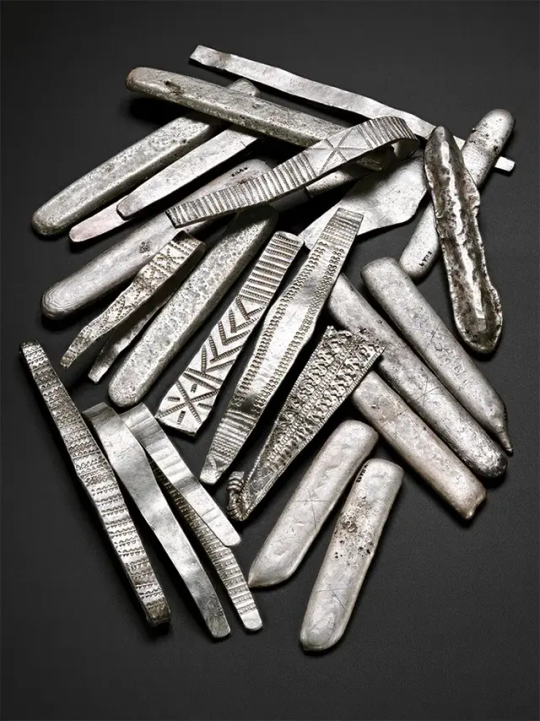

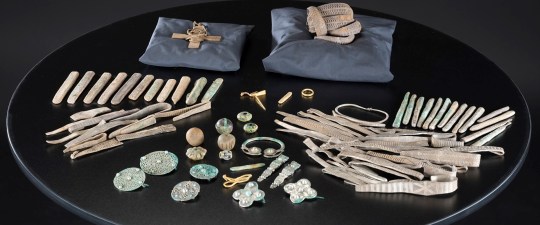
The Galloway hoard, a Viking age treasure hoard consisting of silver ingots, hack silver, silver jewelry, and some gold pieces. Uncovered near Balmaghie, Scotland by a metal detectorist in 2014. Dates to around 900 AD. Currently housed at the National Museum of Scotland.
2K notes
·
View notes
Text
19 notes
·
View notes
Text
Archaeology is cool. I thought this was interesting. Exquisite work on some of those pieces.
Then there's this guy:

#this dude is like the medieval version of the scream by edvard munch#to be clear he is a repro of a part of a larger brooch#but still#i feel you man#archaeology#humor#weird little guy#scotland#galloway hoard#uk
3 notes
·
View notes
Text
When the Galloway hoard was discovered in a ploughed field in western Scotland in 2014, it proved to be the richest collection of Viking-age objects ever found in Britain or Ireland. Now the long-standing mystery of who might have owned it when it was buried more than 1,000 years ago may have been solved.
The spectacular silver and gold treasure had in fact belonged to everybody – “the community” – just as it does today, having been acquired in 2017 by National Museums Scotland (NMS).
The evidence has been found in a runic inscription on one of the hoard’s four elaborately decorated silver “ribbon” arm rings, which has only just been deciphered. It reads: “This is the community’s wealth [property].”
1 note
·
View note
Text
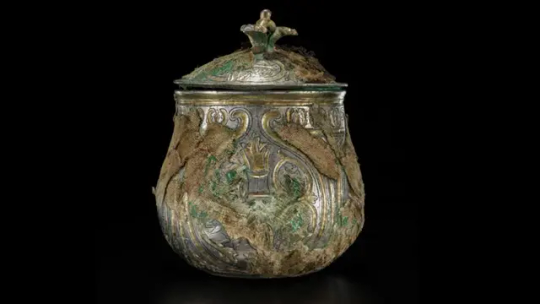
Viking-age Treasure Came to Scotland From West Asia
Ten years on from the discovery of the Viking-age Galloway Hoard in south Scotland, experts have revealed that part of the collection came from West Asia.
The collection - described as one of the most important UK archaeological finds of the century - was found by metal detectorist Derek McLennan in 2014.
A lidded silver vessel was discovered still wrapped in its ancient textiles, which is extremely rare, and meant that the surface of the vessel could at first only be seen through X-ray scans.
Experts say the vessel is originally from what is now central Iran and it was transported halfway around the world more than 1,000 years ago. The vessel was found to contain other treasures, like silk and brooches.
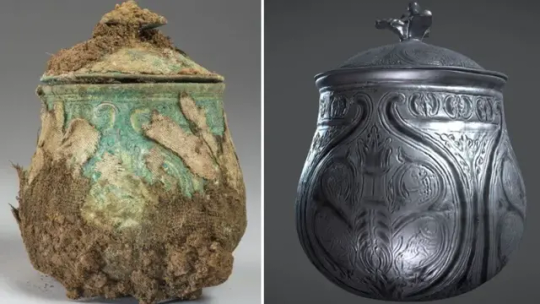

Its textiles have now been partially removed and preserved, and the vessel has been cleaned using lasers which removed any green corrosion and revealed details of the design, including crowns, fire altars, leopards and tigers.
This imagery is unusual in western Europe but it is linked with the iconography of Zoroastrianism, the state religion of the Sasanian Empire which was the last Persian empire before the early Muslim conquests from 632AD.
The hoard - which contained more than 5kg of silver, gold and other materials - was discovered on what is now Church of Scotland land near Balmaghie in the historical county of Kirkcudbrightshire.
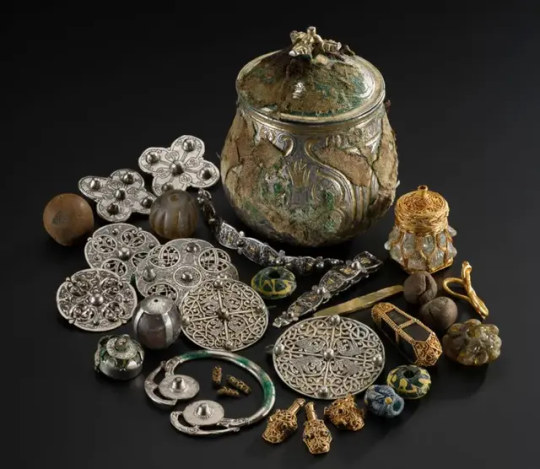

Dr Martin Goldberg from the National Museums Scotland said the vessel was "further evidence of the cosmopolitan make-up of the Galloway Hoard".
He said: "We now know that the Viking-age silver that makes up most of the Hoard was melted down from coins and metalwork from early medieval England.
"Some objects, like the lidded vessel, stood out from the rest and the scientific analysis now confirms this.
"It is incredible to imagine how the vessel made its journey halfway round the known world, from Iran to this distant corner of southwest Scotland.”
The artefact from about 900AD is set to go on public display for the first time next week, on loan to the British Museum’s upcoming Silk Roads exhibition in London.
Other objects from the Galloway Hoard will go on long-term display at the National Museum of Scotland in Edinburgh, while a portion will go on show at Kirkcudbright Galleries.
Dr Sue Brunning, from the British Museum, said: "We're delighted that visitors to Silk Roads will be the first in the world to see this key object from the Galloway Hoard.
"Among its remarkable contents were Scotland's earliest recorded silk, and so it is a highly appropriate inclusion in the exhibition."
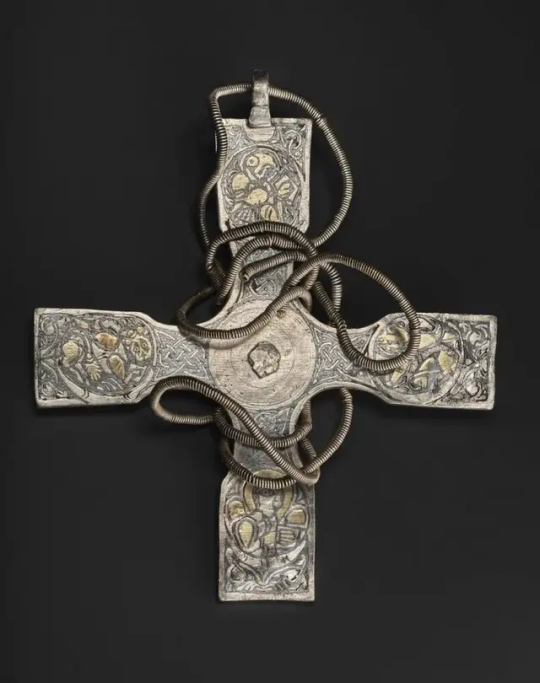
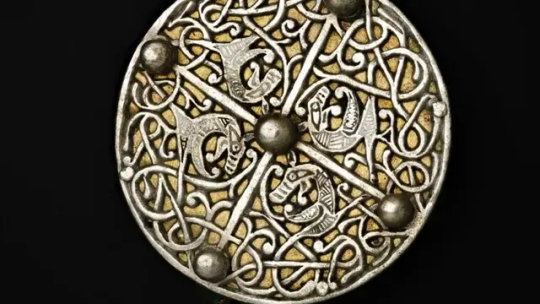
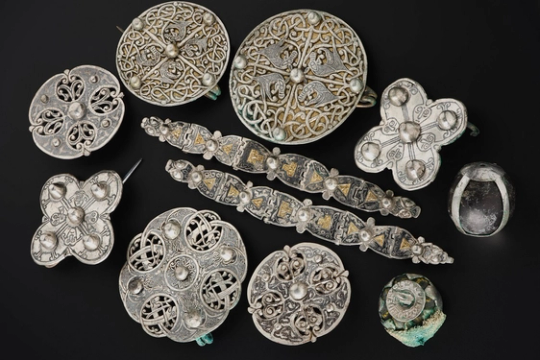
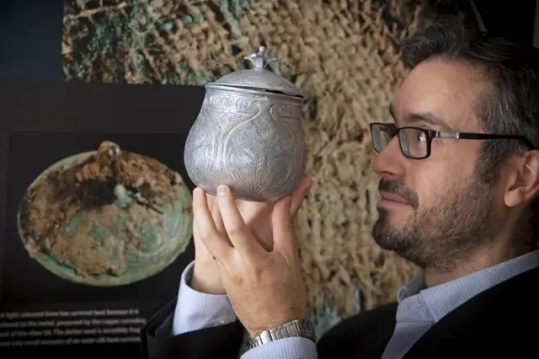
#Viking-age Treasure Came to Scotland From West Asia#Viking-age Galloway Hoard#idded silver vessel#silver#ancient artifacts#archeology#archeolgst#history#history news#ancient history#ancient culture#ancient civilizations#viking age#viking art
98 notes
·
View notes
Text

Prayer from the Pagan
I did it I finished it ughhhhh This scene has stuck in my mind for so long and I just thought that something should have been done, so this happened.
And I even wrote a fic for it. Haha. Help.
Some details for archaeology nerds:


The pattern on the pillow is from the circular brooch found in the Pentney hoard, which was located in East Anglia at the time. In contrast of the celtic brooches worn by vikings, which we are more familiar with, this type of brooches were the one anglo-saxon nobles commonly wore. This one was dated around AD800-840, made in Trewhiddle style, popular in the period Alfred lived in, and it is now in the British Museum.

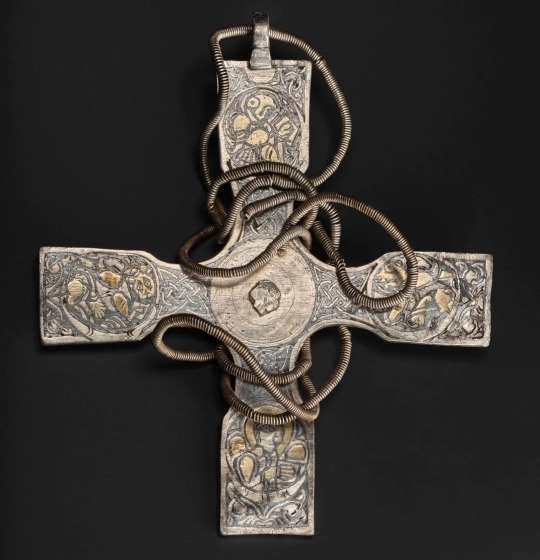
And the cross on the ground is from the pectoral cross found in the Galloway hoard, which at the time was in Northumbria. It was also built in Trewhiddle style, dated around AD900, now in National Museums Scotland, and despite not looking obvious on the picture it was actually made in silver!
And the whole tomb effigy thing—ok, it was not a thing until mid-11th century but since there was one in the tlk universe I just went yolo, lol. I think what the crew took as a reference was the one for Æthelstan, but that was built in 15th century and Æthelstan himself isn’t there, so yeah, that didn’t exist during the time they lived.
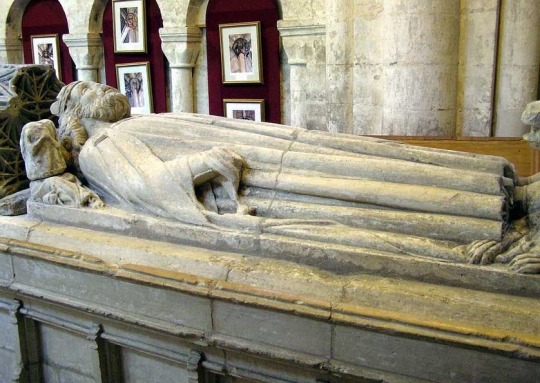
More explanation concerning this topic is in the notes of the fic!
#alfred x uhtred#the last kingdom#tlk alfred#uhtred x alfred#alhtred#it actually took me 25 hours to finish this which is…insane#art block is a bitch lol#I don’t think we’re shown enough of Uhtred mourning Alfred scenes so here it is!#btw not necessarily related to the contents but happy St. Patrick’s day!#hikaruchen#hikaru tlk
180 notes
·
View notes
Text
Heritage News of the Week
Discoveries!
A runic inscription on one of the Galloway hoard’s elaborately decorated arm rings has been deciphered
Carbon dating puts Saskatchewan Indigenous archaeological site at almost 11,000 years old
A piece of charcoal unearthed at a Saskatchewan archaeological site and tested in a lab suggests the site is 11,000 years old and was likely used as a long-term settlement by Indigenous people.
World's largest-ever bead stash found in 5,000-year-old 'Ivory Lady' tomb in Spain
More than a quarter million beads found in a tomb with female skeletons were used to decorate the women's ceremonial dresses, suggesting they were powerful leaders five millennia ago.
Painted tomb uncovered in Etruscan necropolis
Inside the tomb are frescoes depicting scenes of dancing and ancient workshops, which archaeologists have dated to the mid-5th century BC.
Fragments of the world’s oldest known rune stone discovered in Norway
Archaeologists have found fragments of the world’s oldest known rune stone at the Svingerud burial field in Norway and fitted them together like pieces of a jigsaw puzzle.
Researchers get a peek inside another Herculaneum scroll that survived Vesuvius’s eruption
Researchers have been able to generate an image of text from inside a scroll that was buried in ash with the ancient city of Herculaneum by the eruption of Mount Vesuvius that also destroyed Pompeii—a major breakthrough in deciphering its contents. The first word found on the scroll is "disgust."
Carbonized scroll from Herculaneum really capturing the mood
Fresco reveals Islamic tent in medieval Christian worship
A 13th-century fresco in Ferrara, Italy, provides a rare example of medieval churches using Islamic tents to veil high altars.
7,000-year-old bone holds 3 arrowheads with mixed poisons — the oldest of their kind on record
This is the oldest confirmed use of a mixture comprising two or more plant toxins specifically applied to arrowheads.
Excavations planned in the ancient city of Sebastopolis
The latest excavations are currently focused on two main structures: a Roman Bath and a Byzantine Church, however previously unearthed inscriptions indicate other significant public buildings yet to be discovered.
1,500-year-old stained glass and mosaics discovered at Harran Cathedral excavation in Türkiye
Recent excavations at the historic Harran archaeological site have yielded rare mosaic tiles and stained glass fragments that are conjecturally dated to the fifth century, positioning them among the oldest known examples in the region.
Evidence of ancient cultural cannibalism practices uncovered in Poland
In a new study published in the journal Scientific Reports, a taphonomic analysis of 63 human bone fragments from Maszycka Cave has identified cut marks and intentional fractures linked to the extraction of muscle tissue, brain matter, and bone marrow – all indicative of human consumption.
Ancient Tamil Nadu’s metalworking legacy traced back to 3300 BCE
Recent archaeological research has uncovered compelling evidence that Tamil Nadu’s metalworking traditions date back to at least 3300 BCE, highlighting the region’s early advancements in metallurgy.
Dog sacrifices found near ancient royal palace
The Korea Heritage Service announced the discovery of a circular structure with dog bones and various artefacts on the outskirts of an ancient village southwest of the palace.
Discovery of a monumental longhouse from the 3rd century in Norway
Archaeologists have made a groundbreaking discovery at Øvre Eiker near Oslo, Norway, unearthing a longhouse with an astonishing width of 16 meters and a central nave spanning 9 meters between its roof-supporting columns.
Traces of a British fort found in Florida
Soil stains left behind by an eighteenth-century British fort have been uncovered in the Lincolnville neighborhood of St. Augustine
2,500-year-old caravan tombs discovered in the Negev
Archaeologists from the Israel Antiquities Authority have uncovered tombs near Tlalim Junction in the Negev Highlands, revealing trade connections with Yemen, Phoenicia, and Egypt.
Archaeologists uncover gold and silver ritual offerings at a 7th century cult site
Based on the artifacts and postholes, it was determined that the site served as an important cult site during a crucial period of cultural transition on the cusp of the area's Christianization.
Copper Age fortress discovered in Spain
The pentagon-shaped fortress was surrounded by three concentric walls, 25 bastions, and three ditches. Arrowheads, idols, axes, grinding stones, plates, bowls, and loom parts were found inside the structure.
Over 1,000 artefacts found during church excavation
Over 1000 artefacts have been recovered, such as 679 coins and heavily corroded coin fragments, pearls, garment pins, animal bones, ceramics, metal fittings, book clasps, shards of painted glass, iron nails, plant remains, and personal items such as tweezers.
18th-century college dining hall excavated in North Carolina
Archaeologists are excavating the site of Steward’s Hall, the first dining facility on the campus of the University of North Carolina at Chapel Hill.
Nineteen ancient tombs from the 4th century BC unearthed in Padula, Campania
In Padula, located in the Campania region of southern Italy, authorities announced the remarkable discovery of nineteen ancient tombs during archaeological excavations, unearthing a variety of grave goods and artifacts that provide valuable insights into the area’s rich historical and cultural heritage.
Museums
Museums in Canada face several challenges to housing and preserving their collections, let alone displaying those items. And overcrowding is becoming a bigger issue, experts say, from what might be a surprising source — Canadians donating way more fine art and artifacts than the museums can possibly use.
Tiny Nigerian museum marking a forgotten British invasion pushes for recognition
Museum in Koko, Niger Delta, commemorates important exiled merchant prince Nanna Olomu – but it has no cooling and a termite issue
Union decries expected layoffs at Brooklyn Museum
The museum plans to cut staff to address a growing deficit, according to Local 1502, which represents workers including art handlers and curatorial assistants.
Facing $10m budget deficit, Brooklyn Museum will lay off dozens of workers
Museums scramble to grasp impact of Trump’s DEI mandate
Widespread uncertainty pervades as institutions either roll back initiatives or try to determine whether their programs are in compliance.
Closed museum's contents safe, minister tells Senedd
Collections at a major Welsh museum that closed suddenly on Sunday are safe, Wales' minister for culture has said.
Repatriation
The Worcester Art Museum in Massachusetts concluded an agreement this week with the Italian culture ministry to return two antiquities from its permanent collection—a black-figure amphora that dates from between 515 BCE and 500 BCE and a black-figure kylix that has been dated to 500 BCE—that had been illegally taken out of Italy.
Heritage at risk
A haul of 50 Roman coins that were unearthed by a metal detectorist is expected to fetch between £1,200 and £1,500 at auction. He said "something told" him to go to the field, which he had visited "numerous times" and after his metal detector picked up a faint signal, he found two Roman coins in the same hole. Mr Dunn, who has been metal detecting for two years, said he went to get the farmer and dug a further two feet (61cm) down where they found 50 coins. Mr Dunn took the coins in a briefcase to his local finds officer, who spent a year offering them to various museums, which did not wish to claim them.
Sixty centimetres down means the coins were in situ. The article shows that this guy used a digger to find these coins. Any context was destroyed. Screw this guy.

After the collapse of the Assad regime, Syrians are working to preserve their country's heritage
After Assad’s regime collapsed, heritage professionals quickly organised, forming a forum with around 200 people on WhatsApp to exchange information in real time and co-ordinate efforts. Teams were dispatched to assess the conditions of museums and sites where they were accessible.
Discussions about making Rubio acting director of National Archives
There have been extensive discussions at the White House about installing Secretary of State Marco Rubio as the acting director of the National Archives, according to a high-level official, who said the talks began shortly after President Trump's inauguration.
Also re: the US National Archives, back in November it was reported that the National Archivist, Colleen Shogan, was sanitizing exhibits in order to avoid offending Republicans. Anyway, despite complying in advance, she has been fired by Trump.
NSA museum covered plaques honoring women and people of color, provoking an uproar
After a photo from the NSA Museum last week showed that they had papered over plaques about women and people of colour, the plaques have now been uncovered, with the museum saying it was a "mistake".
Congress could soon erase Biden rules on archaeology, climate, and the environment
At-risk rules include one to protect archaeological sites on the ocean floor, such as shipwrecks, from oil and gas drilling.
Egyptologists raise concerns of ‘mismanagement’ after viral video of worker chipping stones at Great Pyramid of Giza
After video of a worker using a hammer, chisel, and other tools on the stones of the Great Pyramid of Giza went viral on social media last November, outrage about the incident has grown to include a statement in Egyptian Parliament and one Egyptologist claiming “mismanagement.”
Odds and ends
UNESCO has completed its reconstruction of the Great Mosque of Al‑Nouri, Al-Tahera Church, and Al-Saa’a Convent in Iraq, as part of its Revive the Spirit of Mosul program. The $115 million initiative, called Revive the Spirit of Mosul, was launched in 2018 in response to the widespread destruction inflicted on cultural heritage by the Islamic State in Iraq.
Who owns underwater heritage?
Amid increasing scrutiny of colonial-era restitution, the time is ripe for a fuller appraisal of sunken artifacts.
Lost historic Gaelic manuscripts found after 50 years
Dozens of Gaelic manuscripts have been found and returned to the National Library of Scotland in Edinburgh after being missing for more than 50 years.
National Register now lists part of Washington Heights as a ‘Dominican Historic District’
A new Dominican Historic District in Washington Heights is officially on the National Register of Historic Places, despite pushback from parts of the community who say they were left out of the designation process.
Unravelling the mysteries of Skye's Fairy Flag
Framed and mounted on a castle wall are the faded and tattered remains of the Fairy Flag of Dunvegan. Legends tell of mythical creatures giving it as a present to the Clan MacLeod, and that it was imbued with powerful magic that could win battles against rival clans.
Christie’s sale of El Greco painting blocked by Romanian government
El Greco’s Saint Sebastian (ca. 1610–14) has been pulled from auction at Christie’s after intervention from the Romanian government, which has claimed the work as being “unequivocally the property of the Romanian state.”
So, where do we think this falls in The Martyrdom Of Saint Sebastian, In Ascending Order Of Sexiness And Descending Order Of Actual Martyring

I'd put this between 10, a Smiths album, and 11, the one used on the cover of an Anne Rice novel
28 notes
·
View notes
Text

Chainmail, Carlingwark Loch, Kelton.
It is probable that this chainmail formed part of a hoard found in a large cauldron by two fisherman about a century ago.
The hoard consisted of native and Roman work, with much of the latter resembling that of Belgic colonists brought to the south east of England by the Romans. Settlers from the same area may have been introduced to Dumfries and Galloway to grow corn to feed the Roman troops.
The rest of the hoard gives a picture of a settled farming community which was well provided with tools, equipment and household furnishings, but which had little need for weapons.
Dumfries Museum, Scotland
#chainmail#archaeology#roman#hoard#native#warfare#defence#metalwork#metalworking#iron age#ancient living#ancient cultures#ancient craft#relic#prehistory
59 notes
·
View notes
Text

Pendant
Viking
793-1066 CE
Pendant, from the Viking age Galloway Hoard
source
106 notes
·
View notes
Text

Gold and stone pendant from the Galloway Hoard in Scotland, circa 500-900 AD
from The National Museum of Scotland
270 notes
·
View notes
Text
The Galloway Hoard: Viking-Age Treasures Embark on International Tour
The Galloway Hoard, will open at the South Australian Museum in Adelaide on 8 February 2025 and run until 27 July 2025. This marks the first time that artifacts from the hoard will be displayed outside the United Kingdom.
14 notes
·
View notes
Text
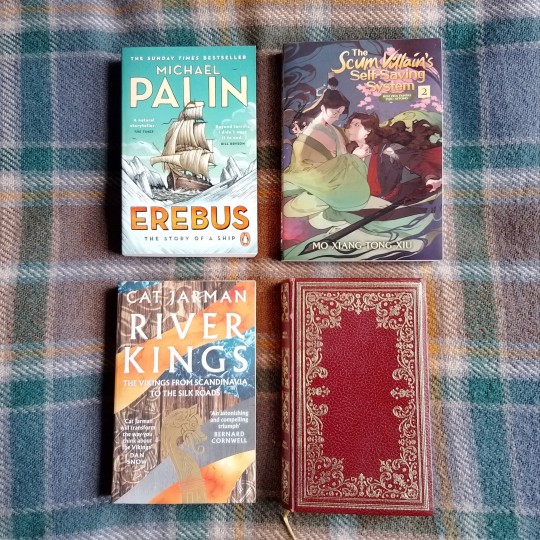
🌧️ January books 🌧️
New year, new reading goal: we're back on 36 total, after making allowance for disruption last year and then massively exceeding it. 😃
🔹Erebus by Michael Palin - 3⭐
I don't think I'll ever get over @jamesfitzjamesdotcom calling this "Error-bus" 😂 It's fine as an introductory work, but the number of mistakes throughout is frankly embarrassing.
🔹 Scum Villain's Self-Saving System volume 2 - 3⭐
This series continues to be entertaining. I like it, but it doesn't have insane-making powers for me. 🤷
🔹 River Kings by Cat Jarman - 4⭐
A great exploration of the impact of Scandinavians in the east during the early medieval period. It starts with the familiar in Britain and works its way step by step through to Constantinople and ultimately India. A refresher for anyone already knowledgeable about the period and an accessible starting point for people who want to learn. Also topical because I'm going to the British Museum at the weekend to steal look upon the Galloway Hoard jar my beloved.
🔹Greenmantle by John Buchan - 2⭐
Recently I inherited a box of beautiful red and gold hardbacks. They're very aesthetic™️, but obviously I can't use books as decor without also reading them. This is the first... It's an entertaining yarn but you can tell it was originally published in 1916. Some wild comments that are no doubt period typical, but unacceptable today. I don't think it has enough literary merit to balance that.
5 notes
·
View notes
Text
5 notes
·
View notes
Text
Mystery behind Viking-age treasure find in Scotland may finally have been solved
// Intresting article about a Viking-age treasure find in Scotland
4 notes
·
View notes
Text
Amazing “Viking” treasure featuring gold, silver, and a vase from Iran may not be Viking at all
ZME Science by Mihai Andrei September 7, 2024 In 2014, a metal detectorist scanning land in southwestern Scotland made a stunning discovery. Buried beneath the soil in the region of Galloway was a trove of seemingly Viking artifacts, from the 9th century. The Galloway Hoard, as it came to be known, became the largest collection of Viking Age treasures ever found in the British Isles. Read more…
2 notes
·
View notes